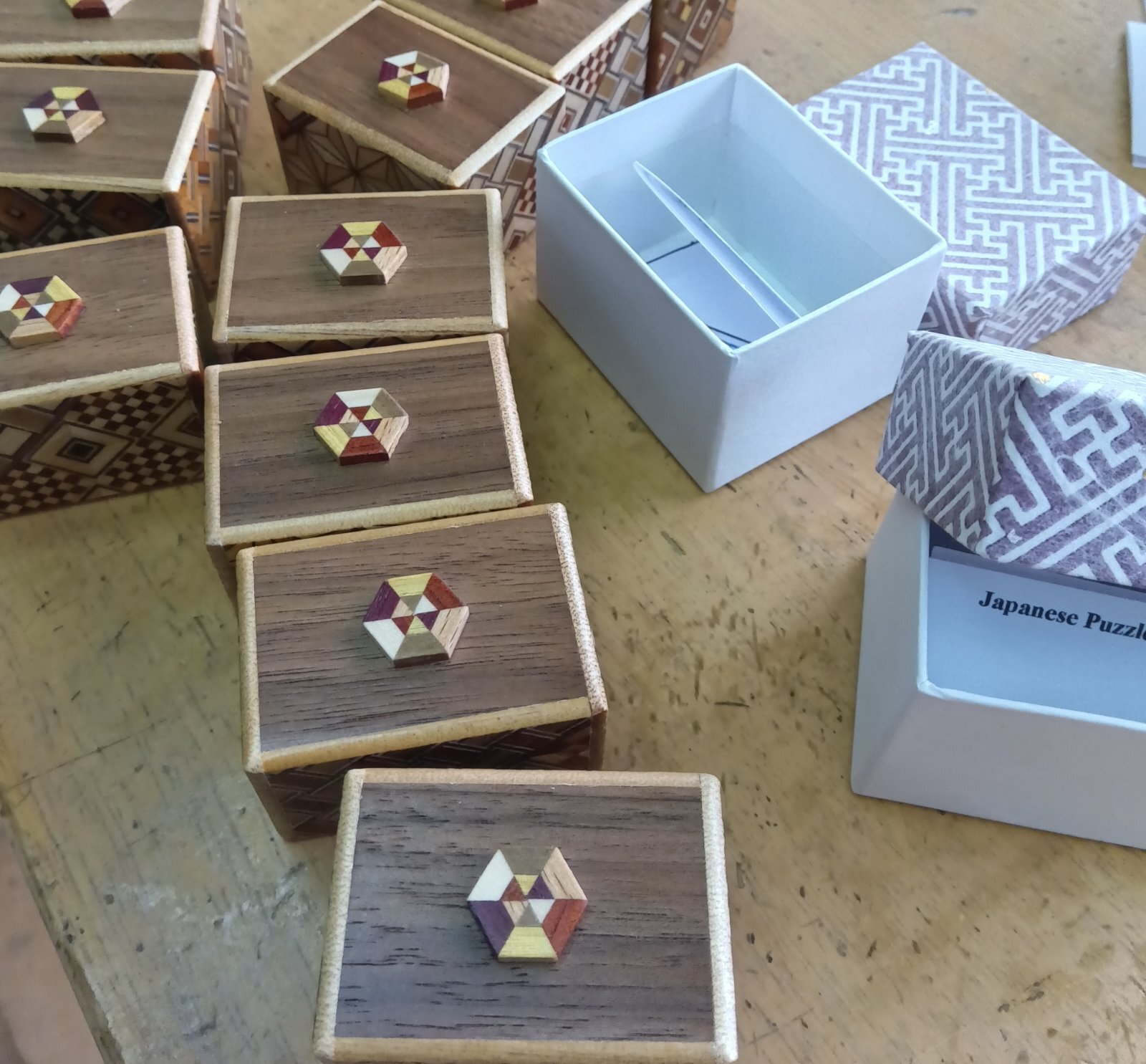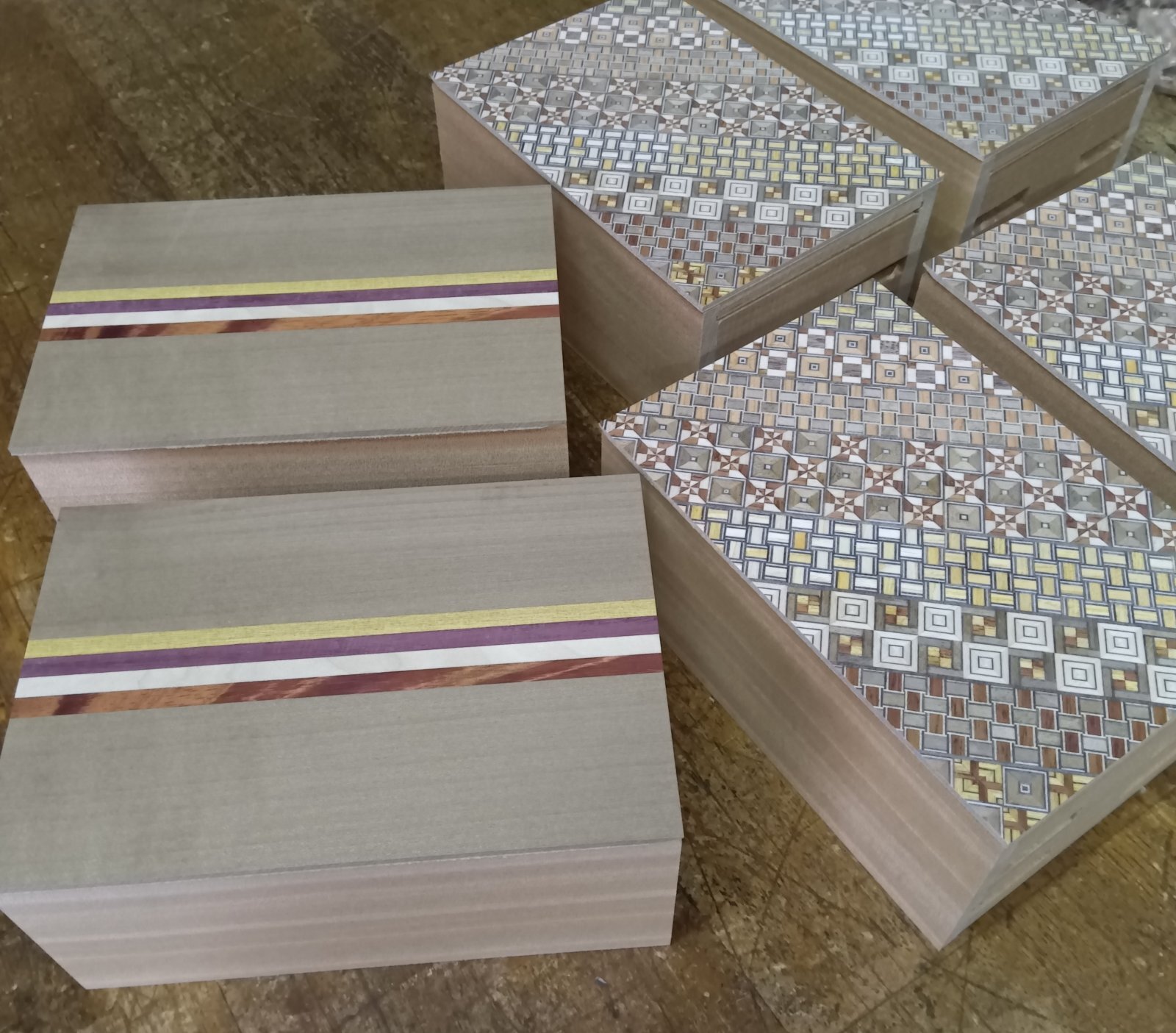Mame gift box
Today, it's raining, and the humidity is high, so my work is somewhat limited. I'm focusing on packaging the completed Mame Himitsubako and 4-sun double compartment Himitsubako into gift boxes. Also, since I need to complete the 54-step Himitsubako by next week, I attached the top panel.
All of my Himitsubako come with a gift box (outer box), even the tiny Mame Himitsubako. As shown in the picture, this paper box is also very small, just like the mame Himitsubako. These paper boxes are made by hand, one by one, by craftsmen. The number of these craftsmen has decreased, and in our region, only two or three remain. The paper box maker I work with had his father, who is already elderly, pass the business on to his son a few years ago (he is younger than me). Thanks to this, I can continue to rely on them for paper box production. I'm grateful for that.
However, it seems that the paper used to make these boxes has recently become scarce. As a result, the paper with the design shown in the photo has already been discontinued, and I have had to switch to a new design for the gift boxes. Once the stock of this design runs out, it will no longer be available, and some of our products have already been switched to blue color gift boxes. The owner of the paper box maker told me that the "washi" paper used for these boxes, which I've been using for about 20 years, is very intricately made and expensive, so there is less demand for it nowadays. Due to the rising cost of the paper and Japan's economic downturn, the paper manufacturer decided to stop production. The new blue design for the boxes is a solid color without any patterns, but this blue is a very distinctive color that represents Japan (we call it "Japan Blue"). While Red is often recognized as Japan's characteristic color, as seen in the national flag, blue has also been passed down as a traditional color since ancient times. That's why this "Japan Blue" has been used in recent years for the uniforms of Japan's national soccer team.
Today, in addition to the above, I attached the top panel for the 54-step Himitsubako, as shown in the photo. Since the humidity is a bit high, I'm not sure if I can move on to attaching the side panels tomorrow, but for now, the top panel needs to be secured with rubber bands and left until tomorrow. There is a deadline for this puzzle box (though it’s not very strict), and I need to ship it by early September. Since this box is being sent to Europe by sea mail, it will take at least two months, possibly three, to arrive. It seems that it will be sold during this year's Christmas sale. But I think it will be finished by next week 👍
All of my Himitsubako come with a gift box (outer box), even the tiny Mame Himitsubako. As shown in the picture, this paper box is also very small, just like the mame Himitsubako. These paper boxes are made by hand, one by one, by craftsmen. The number of these craftsmen has decreased, and in our region, only two or three remain. The paper box maker I work with had his father, who is already elderly, pass the business on to his son a few years ago (he is younger than me). Thanks to this, I can continue to rely on them for paper box production. I'm grateful for that.
However, it seems that the paper used to make these boxes has recently become scarce. As a result, the paper with the design shown in the photo has already been discontinued, and I have had to switch to a new design for the gift boxes. Once the stock of this design runs out, it will no longer be available, and some of our products have already been switched to blue color gift boxes. The owner of the paper box maker told me that the "washi" paper used for these boxes, which I've been using for about 20 years, is very intricately made and expensive, so there is less demand for it nowadays. Due to the rising cost of the paper and Japan's economic downturn, the paper manufacturer decided to stop production. The new blue design for the boxes is a solid color without any patterns, but this blue is a very distinctive color that represents Japan (we call it "Japan Blue"). While Red is often recognized as Japan's characteristic color, as seen in the national flag, blue has also been passed down as a traditional color since ancient times. That's why this "Japan Blue" has been used in recent years for the uniforms of Japan's national soccer team.
Today, in addition to the above, I attached the top panel for the 54-step Himitsubako, as shown in the photo. Since the humidity is a bit high, I'm not sure if I can move on to attaching the side panels tomorrow, but for now, the top panel needs to be secured with rubber bands and left until tomorrow. There is a deadline for this puzzle box (though it’s not very strict), and I need to ship it by early September. Since this box is being sent to Europe by sea mail, it will take at least two months, possibly three, to arrive. It seems that it will be sold during this year's Christmas sale. But I think it will be finished by next week 👍

